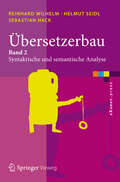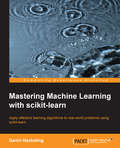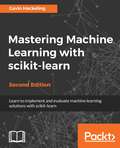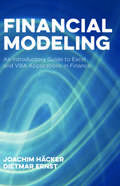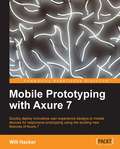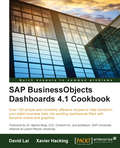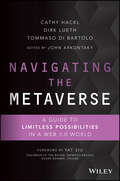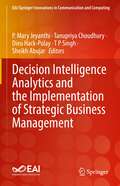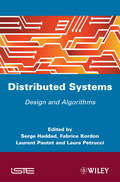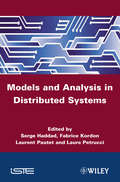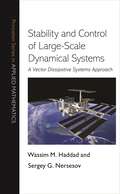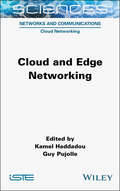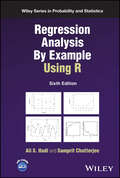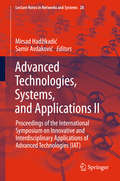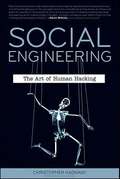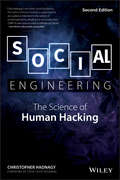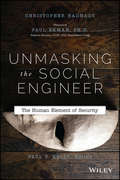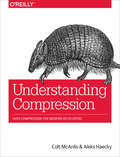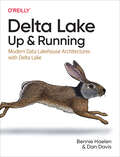- Table View
- List View
Übersetzerbau
by Sebastian Hack Helmut Seidl Reinhard WilhelmDas Buch behandelt die Analysephase von Übersetzern für Programmiersprachen. Die Autoren beschreiben die lexikalische, syntaktische und semantische Analyse sowie Spezifikationsmechanismen für diese Aufgaben aus der Theorie der formalen Sprachen und automatische Erzeugungsverfahren aus der Theorie der Automaten. Vorgestellt wird eine konzeptionelle Übersetzerstruktur, mit der ein Eingabe- in ein Maschinenprogramm transformiert wird. Das Buch enthält neben der notwendigen Theorie auch Hinweise zur Implementierung von Übersetzern.
Mastering Machine Learning with scikit-learn
by Gavin HackelingIf you are a software developer who wants to learn how machine learning models work and how to apply them effectively, this book is for you. Familiarity with machine learning fundamentals and Python will be helpful, but is not essential.
Mastering Machine Learning with scikit-learn - Second Edition
by Gavin HackelingUse scikit-learn to apply machine learning to real-world problems About This Book • Master popular machine learning models including k-nearest neighbors, random forests, logistic regression, k-means, naive Bayes, and artificial neural networks • Learn how to build and evaluate performance of efficient models using scikit-learn • Practical guide to master your basics and learn from real life applications of machine learning Who This Book Is For This book is intended for software engineers who want to understand how common machine learning algorithms work and develop an intuition for how to use them, and for data scientists who want to learn about the scikit-learn API. Familiarity with machine learning fundamentals and Python are helpful, but not required. What You Will Learn • Review fundamental concepts such as bias and variance • Extract features from categorical variables, text, and images • Predict the values of continuous variables using linear regression and K Nearest Neighbors • Classify documents and images using logistic regression and support vector machines • Create ensembles of estimators using bagging and boosting techniques • Discover hidden structures in data using K-Means clustering • Evaluate the performance of machine learning systems in common tasks In Detail Machine learning is the buzzword bringing computer science and statistics together to build smart and efficient models. Using powerful algorithms and techniques offered by machine learning you can automate any analytical model. This book examines a variety of machine learning models including popular machine learning algorithms such as k-nearest neighbors, logistic regression, naive Bayes, k-means, decision trees, and artificial neural networks. It discusses data preprocessing, hyperparameter optimization, and ensemble methods. You will build systems that classify documents, recognize images, detect ads, and more. You will learn to use scikit-learn's API to extract features from categorical variables, text and images; evaluate model performance, and develop an intuition for how to improve your model's performance. By the end of this book, you will master all required concepts of scikit-learn to build efficient models at work to carry out advanced tasks with the practical approach. Style and approach This book is motivated by the belief that you do not understand something until you can describe it simply. Work through toy problems to develop your understanding of the learning algorithms and models, then apply your learnings to real-life problems.
Financial Modeling
by Joachim Häcker Dietmar ErnstNachvollziehbare Modelle zur Beurteilung komplexer Finanzprodukte. Die Autoren bieten Studenten einen anwendungsorientierten Leitfaden zu den zentralen Themenkomplexen Corporate Finance, Derivate und Portfoliomanagement. Zwei Workshops zu Microsoft Excel(r) und der Programmiersprache VBA(r) komplettieren das finanzwirtschaftliche Know-how. Der Kurscharakter des Buches und die praxisnahen Beispiele, die zusatzlich als Download-Angebot zur Verfugung stehen, ermoglichen ein schnelles und interaktives Lernen. Als Nachschlagewerk leistet der Band auch Praktikern wertvolle Dienste. "
Prentice Hall Technology Education: Learning by Design, Revised Edition
by Michael Hacker Dave BurghardtNIMAC-sourced textbook
Mobile Prototyping with Axure 7
by Will HackerThis book is a step-by-step tutorial which includes hands-on examples and downloadable Axure files to get you started with mobile prototyping immediately. You will learn how to develop an application from scratch, and will be guided through each and every step.If you are a mobile-centric developer/designer, or someone who would like to take their Axure prototyping skills to the next level and start designing and testing mobile prototypes, this book is ideal for you. You should be familiar with prototyping and Axure specifically, before you read this book.
SAP BusinessObjects Dashboards 4.0 Cookbook
by Xavier Hacking David LaiThis guide to SAP BusinessObjects Dashboards 4.0 (formerly Xcelsius )is a cookbook packed full of practical recipes written in a clear, concise manner with annotated examples to empower readers to quickly accomplish specific dashboard tasks. If you are a developer with a good command and knowledge of creating dashboards, but are not yet an advanced Dashboard Design user, then this is the perfect book for you. You should have a good working knowledge of Microsoft Excel as well as knowledge of basic dashboard practices, though experience of Dashboard Design as a specific dashboard tool is not essential.
Navigating the Metaverse: A Guide to Limitless Possibilities in a Web 3.0 World
by Cathy Hackl Dirk Lueth Tommaso Di BartoloJump into the metaverse to connect with consumers and explore endless opportunities Like the Internet before it, the metaverse is a virtual space bringing people, companies, and products together in both digital and real environments to create new economic opportunities. The groundwork is already laid. People and organizations jumping in are gaining invaluable experience, meeting customers, developing revenue streams, and even shaping metaverse culture. In Navigating the Metaverse: A Guide to Limitless Business Possibilities in a Web 3.0 World, a team of Silicon Valley thought leaders delivers a groundbreaking discussion of how to find the right opportunities in this fast-moving universe. You'll explore everything from the metaverse basics, to strategy, to launching your first metaverse project. In the book, you'll find: Data and market analysis to erase any doubt that the metaverse is the next big thing. Foundational knowledge about the metaverse, metaverse economy, Web3 technology, and more. The essential connection between metaverse environments, businesses, community, and digital products that make the metaverse economy so powerful. A deep dive on non-fungible tokens (NFTs) and how to make the most of these assets. Frameworks to help find, nurture, measure, and capitalize on innovation in the metaverse. An essential breakdown of the next stage in online business, Navigating the Metaverse belongs in the libraries of entrepreneurs, executives, and innovators looking to lead in the new age of online business and commerce.
Decision Intelligence Analytics and the Implementation of Strategic Business Management (EAI/Springer Innovations in Communication and Computing)
by Dieu Hack-Polay Tanupriya Choudhury P. Mary Jeyanthi T P Singh Sheikh AbujarThis book presents a framework for developing an analytics strategy that includes a range of activities, from problem definition and data collection to data warehousing, analysis, and decision making. The authors examine best practices in team analytics strategies such as player evaluation, game strategy, and training and performance. They also explore the way in which organizations can use analytics to drive additional revenue and operate more efficiently. The authors provide keys to building and organizing a decision intelligence analytics that delivers insights into all parts of an organization. The book examines the criteria and tools for evaluating and selecting decision intelligence analytics technologies and the applicability of strategies for fostering a culture that prioritizes data-driven decision making. Each chapter is carefully segmented to enable the reader to gain knowledge in business intelligence, decision making and artificial intelligence in a strategic management context.
Distibuted Systems: Design and Algorithms (Wiley-iste Ser.)
by Serge Haddad Fabrice Kordon Laurent Pautet Laure PetrucciIn today’s digital environment, distributed systems are increasingly present in a wide variety of environments, ranging from public software applications to critical systems. Distributed Systems introduces the underlying concepts, the associated design techniques and the related security issues. Distributed Systems: Design and Algorithms, is dedicated to engineers, students, and anyone familiar with algorithms and programming, who want to know more about distributed systems. These systems are characterized by: several components with one or more threads, possibly running on different processors; asynchronous communications with possible additional assumptions (reliability, order preserving, etc.); local views for every component and no shared data between components. This title presents distributed systems from a point of view dedicated to their design and their main principles: the main algorithms are described and placed in their application context, i.e. consistency management and the way they are used in distributed file-systems.
Models and Analysis for Distributed Systems (Wiley-iste Ser.)
by Serge Haddad Fabrice Kordon Laurent Pautet Laure PetrucciNowadays, distributed systems are increasingly present, for public software applications as well as critical systems. software applications as well as critical systems. This title and Distributed Systems: Design and Algorithms – from the same editors – introduce the underlying concepts, the associated design techniques and the related security issues. The objective of this book is to describe the state of the art of the formal methods for the analysis of distributed systems. Numerous issues remain open and are the topics of major research projects. One current research trend consists of profoundly mixing the design, modeling, verification and implementation stages. This prototyping-based approach is centered around the concept of model refinement. This book is more specifically intended for readers that wish to gain an overview of the application of formal methods in the design of distributed systems. Master’s and PhD students, as well as engineers in industry, will find a global understanding of the techniques as well as references to the most up-to-date works in this area.
Stability and Control of Large-Scale Dynamical Systems: A Vector Dissipative Systems Approach (Princeton Series in Applied Mathematics #41)
by Wassim M. Haddad Sergey G. NersesovModern complex large-scale dynamical systems exist in virtually every aspect of science and engineering, and are associated with a wide variety of physical, technological, environmental, and social phenomena, including aerospace, power, communications, and network systems, to name just a few. This book develops a general stability analysis and control design framework for nonlinear large-scale interconnected dynamical systems, and presents the most complete treatment on vector Lyapunov function methods, vector dissipativity theory, and decentralized control architectures. Large-scale dynamical systems are strongly interconnected and consist of interacting subsystems exchanging matter, energy, or information with the environment. The sheer size, or dimensionality, of these systems necessitates decentralized analysis and control system synthesis methods for their analysis and design. Written in a theorem-proof format with examples to illustrate new concepts, this book addresses continuous-time, discrete-time, and hybrid large-scale systems. It develops finite-time stability and finite-time decentralized stabilization, thermodynamic modeling, maximum entropy control, and energy-based decentralized control. This book will interest applied mathematicians, dynamical systems theorists, control theorists, and engineers, and anyone seeking a fundamental and comprehensive understanding of large-scale interconnected dynamical systems and control.
Cloud and Edge Networking
by Kamel Haddadou Guy PujolleA major transformation in the world of networks is underway, as the focus shifts from physical technology to software-based solutions. In this book, the authors present this new generation of networks that are based in the Cloud by detailing the transition from a complex environment to a simple digital infrastructure. This infrastructure brings together connected devices, the antennas that collect radio waves, the optical fibers that carry signals and the data center that handles all of the different processes. From this perspective, the data center becomes the brain, managing network services, controls, automation, intelligence, security and other applications. This architecture is relevant to carrier networks, the Internet of Things, enterprise networks and the global networks of the major Internet companies. Cloud and Edge Networking further discusses developments at the border of networks, the Edge, where data is processed as near as possible to the source. Over the next ten years, the Edge will become a major strategic factor.
Recent Advances in Agent-Based Negotiation: Applications and Competition Challenges (Studies in Computational Intelligence #1092)
by Rafik Hadfi Reyhan Aydoğan Takayuki Ito Ryuta ArisakaThis book comprises carefully selected and reviewed outcomes of the 13th International Workshop on Automated Negotiations (ACAN) held in Vienna, 2022, in conjunction with International Joint Conference on Artificial Intelligence (IJCAI) 2022. It focuses on the applications and challenges of agent-based negotiation including agreement technology, mechanism design, electronic commerce, recommender systems, supply chain management, social choice theory, and others. This book is intended for the academic and industrial researchers of various communities of autonomous agents and multi-agent systems, as well as graduate students studying in those areas or having interest in them.
Regression Analysis By Example Using R (Wiley Series in Probability and Statistics)
by Ali S. Hadi Samprit ChatterjeeRegression Analysis By Example Using R A STRAIGHTFORWARD AND CONCISE DISCUSSION OF THE ESSENTIALS OF REGRESSION ANALYSIS In the newly revised sixth edition of Regression Analysis By Example Using R, distinguished statistician Dr Ali S. Hadi delivers an expanded and thoroughly updated discussion of exploratory data analysis using regression analysis in R. The book provides in-depth treatments of regression diagnostics, transformation, multicollinearity, logistic regression, and robust regression. The author clearly demonstrates effective methods of regression analysis with examples that contain the types of data irregularities commonly encountered in the real world. This newest edition also offers a brand-new, easy to read chapter on the freely available statistical software package R. Readers will also find: Reorganized, expanded, and upgraded exercises at the end of each chapter with an emphasis on data analysis Updated data sets and examples throughout the book Complimentary access to a companion website that provides data sets in xlsx, csv, and txt format Perfect for upper-level undergraduate or beginning graduate students in statistics, mathematics, biostatistics, and computer science programs, Regression Analysis By Example Using R will also benefit readers who need a reference for quick updates on regression methods and applications.
Advanced Technologies, Systems, and Applications II: Proceedings of the International Symposium on Innovative and Interdisciplinary Applications of Advanced Technologies (IAT) (Lecture Notes in Networks and Systems #28)
by Mirsad Hadžikadić Samir AvdakovićThis book presents innovative and interdisciplinary applications of advanced technologies. It includes the scientific outcomes of the 9th DAYS OF BHAAAS (Bosnian-Herzegovinian American Academy of Arts and Sciences) held in Banja Vrućica, Teslić, Bosnia and Herzegovina on May 25-28, 2017. This unique book offers a comprehensive, multidisciplinary and interdisciplinary overview of the latest developments in a broad section of technologies and methodologies, viewed through the prism of applications in computing, networking, information technology, robotics, complex systems, communications, energy, mechanical engineering, economics and medicine, to name just a few.
Intuitionistic Fuzziness and Other Intelligent Theories and Their Applications (Studies in Computational Intelligence #757)
by M Hadjiski K T AtanassovThis book gathers extended versions of the best papers presented at the 8th IEEE conference on Intelligent Systems, held in Sofia, Bulgaria on September 4–6, 2016, which are mainly related to theoretical research in the area of intelligent systems. The main focus is on novel developments in fuzzy and intuitionistic fuzzy sets, the mathematical modelling tool of generalized nets and the newly defined method of intercriteria analysis. The papers reflect a broad and diverse team of authors, including many young researchers from Australia, Bulgaria, China, the Czech Republic, Iran, Mexico, Poland, Portugal, Slovakia, South Korea and the UK.
Media�State Relations in Emerging Democracies
by Adrian HadlandThe news media and the state are locked in a battle of wills in the world's emerging democratic states. It is a struggle that will determine whether or not democracy flourishes or withers in the 21st century. Using a number of case studies, including South Africa, this book evaluates what is at stake.
Social Engineering: The Art of Human Hacking
by Christopher HadnagyThe first book to reveal and dissect the technical aspect of many social engineering maneuvers From elicitation, pretexting, influence and manipulation all aspects of social engineering are picked apart, discussed and explained by using real world examples, personal experience and the science behind them to unraveled the mystery in social engineering. Kevin Mitnick-one of the most famous social engineers in the world-popularized the term "social engineering. " He explained that it is much easier to trick someone into revealing a password for a system than to exert the effort of hacking into the system. Mitnick claims that this social engineering tactic was the single-most effective method in his arsenal. This indispensable book examines a variety of maneuvers that are aimed at deceiving unsuspecting victims, while it also addresses ways to prevent social engineering threats. Examines social engineering, the science of influencing a target to perform a desired task or divulge information Arms you with invaluable information about the many methods of trickery that hackers use in order to gather information with the intent of executing identity theft, fraud, or gaining computer system access Reveals vital steps for preventing social engineering threats Social Engineering: The Art of Human Hacking does its part to prepare you against nefarious hackers-now you can do your part by putting to good use the critical information within its pages.
Social Engineering: The Science of Human Hacking
by Christopher HadnagyHarden the human firewall against the most current threats Social Engineering: The Science of Human Hacking reveals the craftier side of the hacker’s repertoire—why hack into something when you could just ask for access? Undetectable by firewalls and antivirus software, social engineering relies on human fault to gain access to sensitive spaces; in this book, renowned expert Christopher Hadnagy explains the most commonly-used techniques that fool even the most robust security personnel, and shows you how these techniques have been used in the past. The way that we make decisions as humans affects everything from our emotions to our security. Hackers, since the beginning of time, have figured out ways to exploit that decision making process and get you to take an action not in your best interest. This new Second Edition has been updated with the most current methods used by sharing stories, examples, and scientific study behind how those decisions are exploited. Networks and systems can be hacked, but they can also be protected; when the “system” in question is a human being, there is no software to fall back on, no hardware upgrade, no code that can lock information down indefinitely. Human nature and emotion is the secret weapon of the malicious social engineering, and this book shows you how to recognize, predict, and prevent this type of manipulation by taking you inside the social engineer’s bag of tricks. Examine the most common social engineering tricks used to gain access Discover which popular techniques generally don’t work in the real world Examine how our understanding of the science behind emotions and decisions can be used by social engineers Learn how social engineering factors into some of the biggest recent headlines Learn how to use these skills as a professional social engineer and secure your company Adopt effective counter-measures to keep hackers at bay By working from the social engineer’s playbook, you gain the advantage of foresight that can help you protect yourself and others from even their best efforts. Social Engineering gives you the inside information you need to mount an unshakeable defense.
Social Engineering and Nonverbal Behavior Set
by Christopher HadnagySocial Engineering: The Art of Human HackingFrom elicitation, pretexting, influence and manipulation all aspects of social engineering are picked apart, discussed and explained by using real world examples, personal experience and the science behind them to unraveled the mystery in social engineering.Examines social engineering, the science of influencing a target to perform a desired task or divulge informationArms you with invaluable information about the many methods of trickery that hackers use in order to gather information with the intent of executing identity theft, fraud, or gaining computer system accessReveals vital steps for preventing social engineering threatsUnmasking the Social Engineer: The Human Element of SecurityFocuses on combining the science of understanding non-verbal communications with the knowledge of how social engineers, scam artists and con men use these skills to build feelings of trust and rapport in their targets. The author helps readers understand how to identify and detect social engineers and scammers by analyzing their non-verbal behavior. Unmasking the Social Engineer shows how attacks work, explains nonverbal communications, and demonstrates with visuals the connection of non-verbal behavior to social engineering and scamming.Clearly combines both the practical and technical aspects of social engineering securityReveals the various dirty tricks that scammers usePinpoints what to look for on the nonverbal side to detect the social engineer
Unmasking the Social Engineer
by Christopher Hadnagy Dr Paul EkmanLearn to identify the social engineer by non-verbal behavior Unmasking the Social Engineer: The Human Element of Security focuses on combining the science of understanding non-verbal communications with the knowledge of how social engineers, scam artists and con men use these skills to build feelings of trust and rapport in their targets. The author helps readers understand how to identify and detect social engineers and scammers by analyzing their non-verbal behavior. Unmasking the Social Engineer shows how attacks work, explains nonverbal communications, and demonstrates with visuals the connection of non-verbal behavior to social engineering and scamming. Clearly combines both the practical and technical aspects of social engineering security Reveals the various dirty tricks that scammers use Pinpoints what to look for on the nonverbal side to detect the social engineer Sharing proven scientific methodology for reading, understanding, and deciphering non-verbal communications, Unmasking the Social Engineer arms readers with the knowledge needed to help protect their organizations.
Phishing Dark Waters
by Christopher Hadnagy Michele Fincher Robin DreekeAn essential anti-phishing desk reference for anyone with an email address Phishing Dark Waters addresses the growing and continuing scourge of phishing emails, and provides actionable defensive techniques and tools to help you steer clear of malicious emails. Phishing is analyzed from the viewpoint of human decision-making and the impact of deliberate influence and manipulation on the recipient. With expert guidance, this book provides insight into the financial, corporate espionage, nation state, and identity theft goals of the attackers, and teaches you how to spot a spoofed e-mail or cloned website. Included are detailed examples of high profile breaches at Target, RSA, Coca Cola, and the AP, as well as an examination of sample scams including the Nigerian 419, financial themes, and post high-profile event attacks. Learn how to protect yourself and your organization using anti-phishing tools, and how to create your own phish to use as part of a security awareness program. Phishing is a social engineering technique through email that deceives users into taking an action that is not in their best interest, but usually with the goal of disclosing information or installing malware on the victim's computer. Phishing Dark Waters explains the phishing process and techniques, and the defenses available to keep scammers at bay. Learn what a phish is, and the deceptive ways they've been used Understand decision-making, and the sneaky ways phishers reel you in Recognize different types of phish, and know what to do when you catch one Use phishing as part of your security awareness program for heightened protection Attempts to deal with the growing number of phishing incidents include legislation, user training, public awareness, and technical security, but phishing still exploits the natural way humans respond to certain situations. Phishing Dark Waters is an indispensible guide to recognizing and blocking the phish, keeping you, your organization, and your finances safe.
Understanding Compression: Data Compression for Modern Developers
by Aleks Haecky Colt McanlisIf you want to attract and retain users in the booming mobile services market, you need a quick-loading app that won’t churn through their data plans. The key is to compress multimedia and other data into smaller files, but finding the right method is tricky. This witty book helps you understand how data compression algorithms work—in theory and practice—so you can choose the best solution among all the available compression tools. With tables, diagrams, games, and as little math as possible, authors Colt McAnlis and Aleks Haecky neatly explain the fundamentals. Learn how compressed files are better, cheaper, and faster to distribute and consume, and how they’ll give you a competitive edge. Learn why compression has become crucial as data production continues to skyrocket; Know your data, circumstances, and algorithm options when choosing compression tools; Explore variable-length codes, statistical compression, arithmetic numerical coding, dictionary encodings, and context modeling; Examine tradeoffs between file size and quality when choosing image compressors; Learn ways to compress client- and server-generated data objects; Meet the inventors and visionaries who created data compression algorithms.
Delta Lake: Up and Running
by Bennie Haelen Dan DavisWith the surge in big data and AI, organizations can rapidly create data products. However, the effectiveness of their analytics and machine learning models depends on the data's quality. Delta Lake's open source format offers a robust lakehouse framework over platforms like Amazon S3, ADLS, and GCS.This practical book shows data engineers, data scientists, and data analysts how to get Delta Lake and its features up and running. The ultimate goal of building data pipelines and applications is to gain insights from data. You'll understand how your storage solution choice determines the robustness and performance of the data pipeline, from raw data to insights.You'll learn how to:Use modern data management and data engineering techniquesUnderstand how ACID transactions bring reliability to data lakes at scaleRun streaming and batch jobs against your data lake concurrentlyExecute update, delete, and merge commands against your data lakeUse time travel to roll back and examine previous data versionsBuild a streaming data quality pipeline following the medallion architecture
